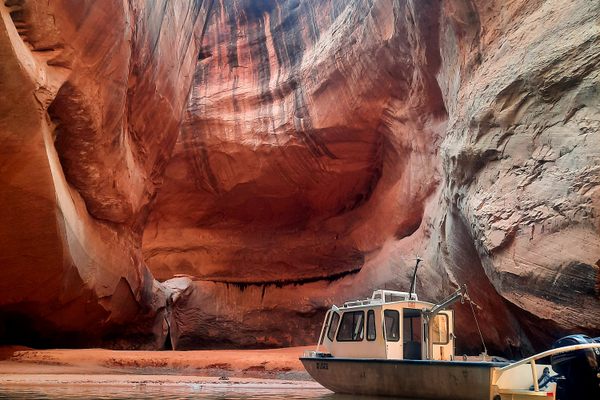The Cow and the Bull
These two giant boulders mysteriously perched on a 60-foot cliff may have been slung up there by a raging tsunami.
Two enormous limestone boulders are perched at the edge of a cliff, on a rocky surface 60 feet above the Atlantic Ocean. They formed on the ocean floor anywhere from 300,000 to 400,000 years ago. So how did they get up there?
The rocks, known locally as the Cow and the Bull, are part of a mysterious series of giant boulders on the coast of Eleuthera island in the Bahamas. Seven massive rocks form an almost perfect line along an especially narrow portion of the 110-mile coastline. The “Cow” and the “Bull” weigh 1,000 and 2,000 tons respectively and are each over 20 feet tall. Some scientists believe the massive boulders may have been lifted to the clifftop millennia ago by a powerful tsunami caused by the changing climate.
Bahamians refer to the area’s massive waves—powerful enough that they have displaced the concrete slabs of a road just north of the boulders—as “rages.” James Hansen, a retired NASA scientist, believes those waves were even more powerful 100,000 years ago during catastrophic superstorms produced by a warming period known as the Eemian.
The oceans rose a great deal towards the end of the Eemian, and Hansen theorizes it was during that time tsunamis slung the boulders up onto the cliff. The informative placards for visitors concur, claiming the ocean “lifted them atop the ridge.”
There is contention, however, among scientists. Hansen is often referred to as “the father of global climate change awareness,” and his opposition believes his explanation is just a ploy to bring more attention to the issue. Hansen’s claim isn’t unprecedented, though; a recent study in the Cape Verde islands off the coast of Africa claims boulders up to 700 tons were lifted more than 900 feet by tsunamis some 73,000 years ago.
Some believe the boulders were simply left there after the surrounding rocks eroded to nothing, but that neglects the age of the boulders and the much younger surface below. Regardless of the specifics, something dramatic happened to the landscape so many years ago.
Plan Your Trip
The Atlas Obscura Podcast is Back!


















Follow us on Twitter to get the latest on the world's hidden wonders.
Like us on Facebook to get the latest on the world's hidden wonders.
Follow us on Twitter Like us on Facebook